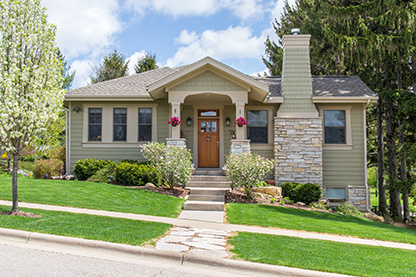Houses built on hillsides or steep slopes are often set on tall, narrow posts or columns, with or without diagonal bracing, and may have walls that “step down” the hill.
This means the foundation must be able to withstand the weight of the house bearing downhill, and support the house’s entire structure, for it to not collapse or slide away.
Houses built on hillsides or steep slopes (steep hillsides) without special seismic detailing may be in danger of swaying and could even collapse during an earthquake. Two major foundation issues include:
- houses supported on one or more sides by tall poles or columns and,
- houses with a crawlspace under the floor with a very tall wall at one end and stepped walls on one or more sides.
Certain structural elements inherent in hillside houses create vulnerabilities, and many may not be properly braced to withstand earthquakes.
For example, drainage systems could weaken or shift the soil, and tree roots or soil erosion can further challenge the house’s stability and ability to resist shake damage.
These factors of a hillside house can lead to significant damage and even collapse during an earthquake.
Hillside House Retrofit Details
Because they are uniquely built to the hillside or slope that they rest on or along, the retrofit for a house on a hill cannot be developed from a standard plan set.
Since hillside houses require an engineered retrofit, it is advised to hire a licensed structural or civil engineer to assess the structure, and then develop a particular plan for your specific house’s retrofit needs.
A house partially or fully supported on poles or columns without engineered cross bracing may require a retrofit with new bracing elements or new foundations and shear walls along the perimeter of the house.
A house with a tall crawlspace under the floor may require the following:
- Foundation: the hillside house will need a continuous perimeter foundation. If it already has one, the foundation must be free of deterioration and soil underneath must be intact.
- Anchorage of framed crawlspace walls to the foundation: The crawlspace walls need to be anchored and bolted to the foundation. If anchor bolts and/or retrofit anchors already exist, they will be assessed to make sure they are in accordance with modern building codes.
- Braced wall sheathing: Crawlspace walls need to be braced with materials that can better withstand shaking. The wall sheathing will be assessed to see if it meets modern standards. If it does not, the walls can be replaced or updated to be compliant.
We recommend that the licensed structural or civil engineer you hire follow guidance prepared by the Applied Technology Council, FEMA and CEA, called the Vulnerability-Based Seismic Assessment and Retrofit of One- and Two-Family Dwellings.
You may begin your own research on hillside home retrofits by reviewing Chapter 6 of this guide, which includes illustrations of the three types of requirements listed above.
Is a hillside house worth it?
If your home is damaged, you may not be able to live inside it while repairs are made. And remember, while you may be able to take out loans to repair or rebuild, you will have to pay to live elsewhere all while still paying your mortgage.
With hillside houses, there is a risk of total collapse and danger to those inside or around the home when an earthquake strikes. Every region of California faces earthquake risks, which makes earthquake preparedness an important component of protecting yourself and your family.
Learn more about the types of vulnerabilities in hillside houses in a new publication “Earthquake Damage Assessment and Repair Guidelines for Residential Wood-Frame Buildings” from experts from CEA and the Applied Technology Council (ATC).
Cost benefit analysis
Since hillside houses require an engineered retrofit, the cost of an earthquake retrofit will be higher than for simply a brace and bolt or bolt only retrofit. Oftentimes for houses of this type, a plan needs to be developed for the specific house itself, and there is not a standard plan set that can be used. The cost for an engineered retrofit of a hillside house can be upwards of $10,000.
Although these up-front costs may seem alarming, so would the catastrophic loss to your home from an earthquake. Completing a retrofit makes your home stronger, and safer for you and your loved ones. By spending money up front on a retrofit to strengthen your property now, you’re investing in the long-term resilience of your biggest investment.
It’s peace of mind for the safety of your family, and confidence in the strength and security of your home.
Ready to take the next step?
Adequately strengthening a hillside house requires a retrofit specific to the individual house’s needs. You should hire a licensed structural or civil engineer to advise on your retrofit efforts.
Move forward and take the next step on strengthening your house today.
We have additional resources for you, including what questions to ask and how to pay for the retrofit.



